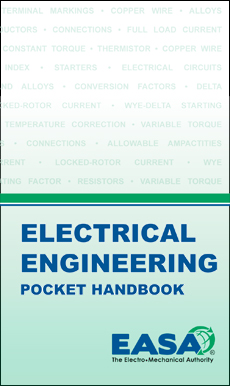 DESCRIPTION
DESCRIPTION
Filled with practical information, this 118-page handbook (3.5" x 6", 9cm x 15cm) makes a great “give-away” item for your customers and potential customers! Buy this great resource as is OR custom brand your company logo and information on the cover to turn it into a great marketing piece for your salespeople!
BUY COPIES OF THIS HANDBOOK
TABLE OF CONTENTS
MOTOR DATA–ELECTRICAL
Standard Terminal Markings and Connections
DC Motors and Generators (NEMA & IEC Nomenclature)
Field Polarities of DC Machines
General Speed-Torque Characteristics
Full-Load Efficiencies of Energy Efficient Motors
Full-Load Efficiencies of NEMA Premium™ Efficient Motors
Effect of Voltage Variation on Motor Characteristics
Power Supply and Motor Voltages
Effect of Voltage Unbalance on Motor Performance
Starting Characteristics of Squirrel Cage Induction Motors
Allowable Starts and Starting Intervals
MOTOR DATA–MECHANICAL
Suffixes to NEMA Frames
NEMA Frame Assignments–Three-Phase Motors
NEMA Frame Dimensions–AC Machines
IEC Mounting Dimensions–Foot-Mounted AC and DC Machines
IEC Shaft Extension, Key And Keyseat Dimensions–Continuous Duty AC Motors (Inches)
NEMA Shaft Extension And Keyseat
Dimensions–Foot-Mounted DC Machines (Inches)
NEMA Frame Dimensions–Foot-Mounted DC Machines (Inches)
NEMA Frame Dimensions–AC Machines (mm)
IEC Mounting Dimensions–Foot-Mounted AC and DC Machines (mm)
IEC Shaft Extension, Key and Keyseat Dimensions–Continuous Duty AC Motors (mm)
NEMA Shaft Extension and Keyseat Dimensions–Foot-Mounted DC Machines (mm)
NEMA Frame Dimensions–Foot-Mounted DC Machines (mm)
MOTOR CONTROLS
Power Factor Improvement of Induction Motor Loads
Capacitor kVAR Rating for Power-Factor Improvement
Full-Load Currents–Motors
Maximum Locked-Rotor Currents–Three-Phase Motors
NEMA Code Letters for AC Motors
Starter Enclosures
NEMA Size Starters for Three-Phase Motors
NEMA Size Starters for Single-Phase Motors
Derating Factors for Conductors in a Conduit
Allowable Ampacities of Insulated Conductors
Motor Protection Devices–Maximum Rating or Setting
TRANSFORMERS
Full-Load Currents for Three-Phase Transformers
Full-Load Currents for Single-Phase Transformers
Transformer Connections
MISCELLANEOUS
Temperature Classification of Insulation Systems
Resistance Temperature Detectors.
Thermocouple Junction Types
Dimensions, Weight and Resistance: Solid Round Copper Wire (AWG and Metric)
Square Bare Copper Wire (AWG)
Insulation Resistance and Polarization Index Tests
Properties of Metals and Alloys
USEFUL FORMULAS AND CONVERSIONS
Temperature Correction of Winding Resistance
Temperature Correction of Insulation Resistance.
Formulas for Electric Motors and Electrical Circuits.
Motor Application Formulas
Centrifugal Application Formulas
Temperature Conversion Chart
Conversion Factors
Fractions of an Inch–Decimal and Metric Equivalents
Related Reference and Training Materials
Print
